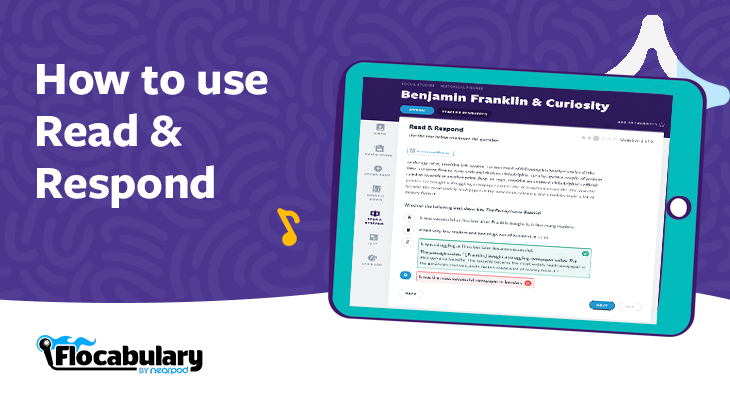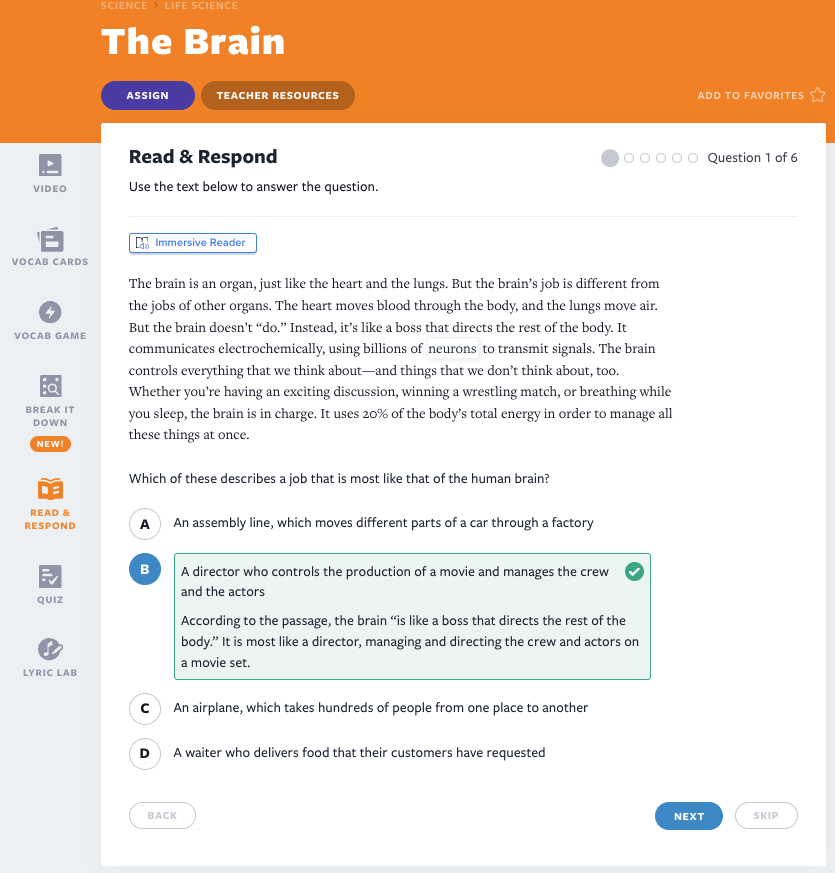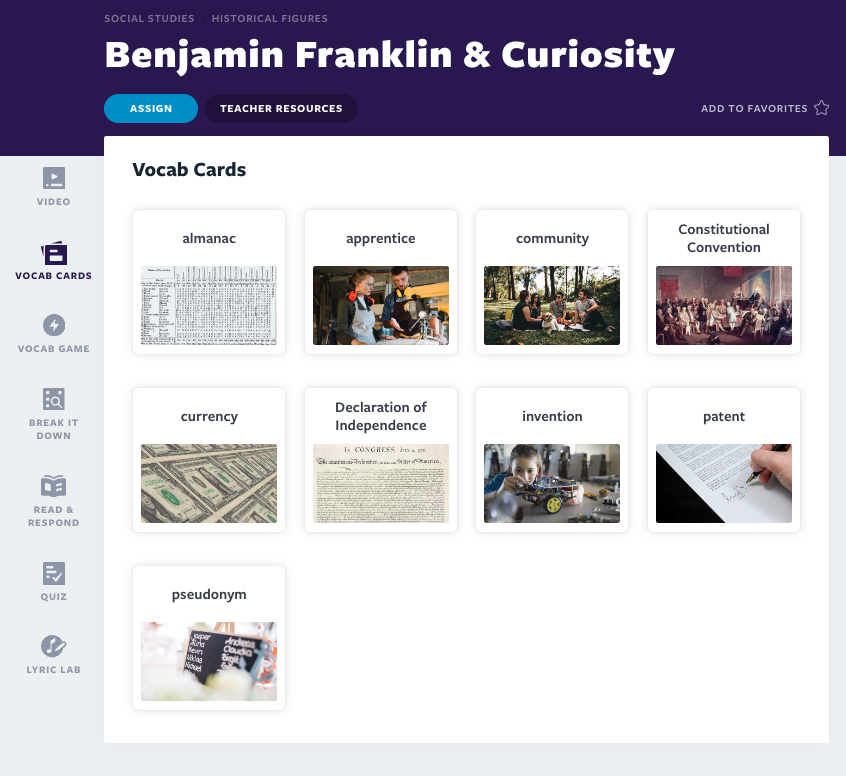
How Read & Respond builds reading comprehension skills
Flocabulary videos are engaging and educational, but their impact is even more powerful when they don’t stand alone. Each is part of a carefully structured lesson sequence that guides students through activities to reinforce what they learn and increase their depth of knowledge, enabling them to apply their learning in meaningful ways.
Flocabulary includes built-in features like the Video, Vocab Cards, or Quiz functionalities and activities such as the Vocab Game, Break It Down, Read & Respond, and Lyric Lab. Each feature and activity focuses on different levels of Bloom’s Taxonomy and is designed to deepen students’ learning and understanding.
The Read & Respond focuses on analysis, the fourth level of Bloom’s Taxonomy, where students identify patterns, categorize, compare, and contrast ideas and information. In this post, let’s explore the Read & Respond activity, how it works, and why it’s such a great tool for the classroom.
What is Read & Respond in Flocabulary?
Flocabulary’s Read & Respond feature is an integral component of the Flocabulary lesson sequence. Available with all subscription types, Read & Respond provides short, assignable reading passages that elaborate on the content in the Flocabulary video alongside text-dependent, multiple-choice comprehension questions. These passages enable students to dive deeper into the unit’s content while building their reading comprehension skills.

New to Flocabulary? Teachers can sign up for a trial to access our lesson videos and assessment activities. Administrators can get in touch with us to learn more about unlocking the full power of Flocabulary through Flocabulary Plus.
How to use Read & Respond in the classroom
Read & Respond works as a front-of-classroom approach for the entire class and as an independent activity for individual students. As with other activities in a Flocabulary lesson sequence, teachers can reassign Read & Respond to retake, allowing students to learn from their mistakes and ultimately succeed with the material.

Each passage is accompanied by a multiple-choice question targeting one of five standards-aligned skills: Reading closely, identifying key details, making inferences, analyzing the author’s perspective, and identifying the main idea or theme. Students answer these questions within the Flocabulary unit’s lesson sequence. This streamlined workflow emulates a similar structure to what students experience on high-stakes tests. Importantly, the Read & Respond activity also includes correct-answer explanations, which appear on the screen after the question is answered.
When students complete a Read & Respond activity, responses are sent directly to the teacher’s classroom dashboard, where data can be reviewed both classwide and individually.
How to use Read & Respond in the classroom
In light of poor reading outcomes and an ever-growing research base, districts are increasingly shifting from less effective reading instruction methods (e.g., three-cueing or leveled readers) to instruction grounded in phonics and word recognition. The Science of Reading is an evidence-based, interdisciplinary approach to reading and writing that focuses on teaching students foundational skills. Critical among these are phonics and how to decode words.
However, decoding alone is not enough; students must also learn to make meaning from what they read. Comprehension, including an understanding of phonics and decoding alongside background knowledge, context, and vocabulary, is critical to overall literacy and reading mastery. Flocabulary’s Read & Respond feature helps students build capacity and competence in reading comprehension while growing their vocabulary and background knowledge.
How Flocabulary’s Read & Respond activity builds reading comprehension skills
1. Building background knowledge
Background knowledge has a significant and powerful effect on reading comprehension. You can experience this firsthand by reading the two texts below. These texts were adapted from current Flocabulary Read & Respond passages from the Benjamin Franklin & Curiosity and Nuclear Physics lessons. They have identical word counts of 40 words each. As you read, try to guess which text has the higher complexity as determined by their Lexile measures.
Passage One from Benjamin Franklin & Curiosity
Benjamin Franklin published Poor Richard’s Almanack every year for 25 years. At that time, almanacs contained a calendar, weather forecasts, farming advice, and other useful information. Franklin’s almanac was famous in part because it included many clever sayings or aphorisms.
Passage Two from Nuclear Physics
Because it is unstable, the uranium-238 nucleus undergoes alpha decay. This process involves the loss of two protons and two neutrons. Alpha decay results in the transmutation of the uranium-238 nucleus to a nucleus with 90 protons and 144 neutrons—thorium-234.
The connection between text complexity and background knowledge
At Flocabulary, we use the Lexile framework to measure text complexity. The higher the Lexile measure, the more complex the text. Which passage do you think has the higher Lexile score? If you guessed Passage One, you’re correct! Though Passage Two may have seemed more complex, its Lexile measure is only 1050, while Passage One’s is 1120.

So, how does Passage One feel easier to understand despite having a higher Lexile measure? Background knowledge! Students (and adults) will likely be more familiar with concepts like weather forecasts and calendars than alpha decay and transmutation. The deeper a reader’s background knowledge is, the more complexity they can handle, and, of course, the more their reading comprehension skills will grow. For example, if you’re not already a physics buff, watch our video on Nuclear Physics, then read Passage Two again. You’ll have a much better grasp of it thanks to the background knowledge you built from watching this video.
Flocabulary recognizes how crucial background knowledge is to understanding and comprehension—that’s why it’s built into every aspect of our lesson sequence. This is why the Read & Respond texts expand upon the content featured in the video rather than introducing entirely new subjects. The newly acquired background knowledge will have improved your reading comprehension—which is exactly what happens for students who engage in our lesson sequence!
You can take advantage of the background knowledge effect by leveraging the full Flocabulary lesson sequence. Have students complete other lesson sequence components before attempting Read & Respond. Start with the video to pique their interest and get them grounded in the subject. Then, you can move on to the Break it Down, Vocab Cards, Vocab Game, and Quiz features and activities. By the time your students get to Read & Respond, they’ll be primed for success.
2. Vocabulary, vocabulary, vocabulary
Education research unequivocally demonstrates that robust vocabulary knowledge is key to reading comprehension while lacking vocabulary knowledge hinders it. To keep up with the increased academic rigor of each grade level, it is recommended that students learn 2,000 to 3,000 new words per year. This monumental task cannot be achieved by incidental learning alone. Effective vocabulary instruction is, therefore, an essential component of K-12 curricula. This is why vocabulary words are the building blocks of every Flocabulary lesson across all subjects.
Each set of vocabulary words in a Flocabulary unit is carefully selected, including Tier 2 and Tier 3 words. As students move through the activities in the Flocabulary lesson sequence, they gain repeated, varied exposures to these key vocabulary words. These repeated exposures are crucial for developing a deep and lasting understanding of new vocabulary, as single exposures to new words are insufficient for authentic learning. This is why Flocabulary’s vocabulary words are woven into the song lyrics, used for Vocab Cards and the Vocab Game, and appear in the Read & Respond passages.

Consider the word ‘almanac,’ a vocabulary word for the Flocabulary lesson Benjamin Franklin and Curiosity, which also appears in Passage One earlier in this article. Students who were to cold read Passage One—meaning without any prior instruction or beefing up of vocabulary—could get stuck on the word ‘almanac.’ This could cause them to lose the thread of the passage and possibly to lose interest and motivation. But if they were to encounter this passage after mastering other parts of the lesson sequence, they would have already had several exposures to the word. In this case, they would be much more likely to understand it in the context of Passage One.
3. Addressing vocabulary barrier
Suppose that despite multiple and varied exposures, a student can’t recall the meaning for the word ‘almanac’ while reading the Read & Respond passage. Here’s Passage One again. As you can see, the word ‘almanac’ (or ‘Almanack’) appears in all three sentences!
Passage One
Benjamin Franklin published Poor Richard’s Almanack every year for 25 years. At that time, almanacs contained a calendar, weather forecasts, farming advice, and other useful information. Franklin’s almanac was famous in part because it included many clever sayings or aphorisms.
Overcoming vocabulary clunks for better comprehension
Students unfamiliar with the word may be able to use context clues to deduce the meaning. But what about students who have not yet mastered context clues? Given how central the word is to the paragraph’s meaning, they likely wouldn’t be able to interact with the text in a meaningful way. They might be able to decode ‘almanac,’ but their comprehension of the passage would simply clunk to a halt. Indeed, that is why reading experts refer to unknown vocabulary words or phrases that interfere with student comprehension as ‘clunks.’

Read & Respond passages have a solution to this: Every vocabulary word in the passage is clickable. A student who doesn’t remember the meaning of ‘almanac’ can simply click on the word, and its Vocab Card will instantly pop up. Flocabulary’s Vocab Cards, designed with the Frayer Model in mind, provide a student-friendly definition of the word, its part of speech, its synonyms and antonyms, a usage example, and an image. This information enables students to get past the clunk and continue to make meaning from the text.
4. Metacognition opportunities
Research shows that strong readers engage in metacognition, or awareness of their own thought processes, as they read. They continuously assess their comprehension of the material so that they’re aware when their understanding becomes compromised. At this point, they ‘repair’ the problem. For vocabulary, the repair process can include looking up the word.
The vocabulary exposure that students engage in before Read & Respond and the clickable words in the activity prompt students to engage in this self-assessment and repair process, strengthening their metacognition skills.

Read & Respond offers another metacognition opportunity as well. When students answer a question in Read & Respond, they are given immediate feedback as to whether it is correct or incorrect. They then receive an explanation for why the correct answer choice is correct, along with supporting in-text evidence. This strategy cues students to consider whether their choice was correct and why. They can use this information to consider where their reasoning went off track (if they answered incorrectly), again building the habit of thinking about their own thinking.
Start using Read & Respond on Flocabulary
At Flocabulary, we believe that teaching is the most important job in the world. We also know that it’s one of the most challenging jobs. We’re committed to providing instructors with the most effective tools possible.
Read & Respond includes original and reprinted nonfiction, fiction, and poetry readings, carefully crafted to extend the learning material introduced in the video. With Read & Respond, students will not only deepen their comprehension skills, build vocabulary, and broaden their background knowledge—they’ll also interact with the text and lesson in a meaningful way that stays with them for years to come.
New to Flocabulary? Teachers can sign up for a trial to access our lesson videos and assessment activities. Administrators can get in touch with us to learn more about unlocking the full power of Flocabulary through Flocabulary Plus.
